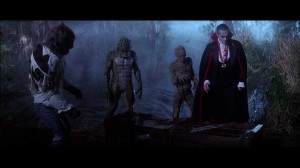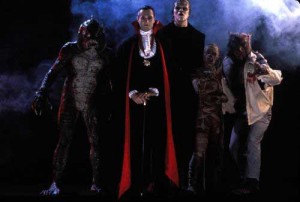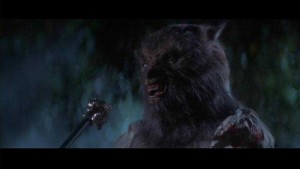
When tasked with conjuring fresh versions of the Universal Studios classic monsters for the 1987 feature film, The Monster Squad, director Fred Dekkerand the film’s producers faced a dilemma: the looks of the iconic Universal monsters featured in the new film were “copywritten” by Universal Studios.
Of course, Count Dracula and the Frankenstein monster were based on literary works, even so, Monster Squad’s makers were not allowed to visually reference the legendary visages of the Béla Lugosi version of Dracula or the Boris Karloff appearance as the Frankenstein monster, both under Universal’s domain. An added difficulty was that the characters of The Mummy, The Wolf Man and The Gill-Man were all technically original Universal creations and were thus outright owned and designated as Universal properties.
How does one solve such a problem when your film directly uses those classic characters? The filmmakers sought Stan Winston Studio, who in the mid-1980s was fresh off such makeup and monster-filled projects as The Terminator and Aliens.
First, Winston assigned his top designers to sketch new versions of the classic monsters, each quoting the looks of the Universal characters, but taking a new approach to their basic appearance. Next, he assigned each member of his young gun team of nascent makeup artists in residence at his studio an individual classic character for which that artist would be solely responsible.
 The celebrated Frankenstein monster was given to Tom Woodruff, Jr., an ambitious makeup and creature artist who started with Winston in the early 1980s. Using a basic thick-headed prominence with stitches across the neck and electrodes at his neck, Woodruff, Jr.’s Frankenstein monster evoked Karloff’s three turns as the monster in Jack Pierce makeup during the 1930s while offering its own taller, thinner personage of actor Tom Noonan.
The celebrated Frankenstein monster was given to Tom Woodruff, Jr., an ambitious makeup and creature artist who started with Winston in the early 1980s. Using a basic thick-headed prominence with stitches across the neck and electrodes at his neck, Woodruff, Jr.’s Frankenstein monster evoked Karloff’s three turns as the monster in Jack Pierce makeup during the 1930s while offering its own taller, thinner personage of actor Tom Noonan.
Aspiring monster maker Alec Gillis, who would later partner with Woodruff, Jr. in their own makeup and creature company, Amalgamated Dynamics, Inc., was tasked with creating the Frankenstein monster’s counterpart, Count Dracula. As a variation of Lugosi’s Dracula, Gillis’ version is equally haunting, and he added a man-bat “transformation” to his duties as his Dracula was not the heavy prosthetic job of Woodruff Jr.’s Frankenstein Monster.
For the film’s other three monsters, which were Universal’s sole property, even more variation was required. As many monster fans may know, Jack Pierce had created the pioneering character of The Wolf Man with Lon Chaney, Jr. in four films through the 1940s. Stan Winston Studio stalwart John Rosengrant – who later formed Legacy Effects with Shane Mahan and other SWS personnel. – was assigned the Wolf Man character, realized with both prosthetic makeup and a puppet head for a transformation sequence. More animalistic than Pierce’s version, Rosengrant’s Wolf Man features widely separated eyes and vertically protruding ears.
 More diminutive and lanky than his fellow Squad members was Mahan’s creature fabrication of The Mummy. Jack Pierce had created the legendary Im Ho Tep Mummy in 1932 with Boris Karloff, and he did all four Mummy sequels in the 1940s, first with Tom Tyler, then with Chaney, Jr. on the last three films. With the mid-1980s version, Mahan provided a heavily bandaged and aged character, played by 5-foot-7-inch Michael Reid MacKay who was so small, that he offered a believably decrepit character, with eroding facial features to boot.
More diminutive and lanky than his fellow Squad members was Mahan’s creature fabrication of The Mummy. Jack Pierce had created the legendary Im Ho Tep Mummy in 1932 with Boris Karloff, and he did all four Mummy sequels in the 1940s, first with Tom Tyler, then with Chaney, Jr. on the last three films. With the mid-1980s version, Mahan provided a heavily bandaged and aged character, played by 5-foot-7-inch Michael Reid MacKay who was so small, that he offered a believably decrepit character, with eroding facial features to boot.
Last on the Monster Squad roster was the Gill-Man, made famous in three 1950s Creature from the Black Lagoon films. In those Universal films, Bud Westmore had supervised a “dream team” of makeup and creature artists, much like the Winston team of the 1980s. Conceptual artist Millicent Patrick, key sculptor Chris Mueller, and suit fabricator Jack Kevan had all contributed to the original Gill-Man in 1953 and 1954.
For Monster Squad, the job went to two 20-something stars on the rise at SWS: Steve Wang and Matt Rose. With the two working as a team, Wang blocked out the bodily sculpture and Rose designed the head. Both contributed many details to the overall look and paint scheme. The Gill-Man of Monster Squad gained nearly the acclaim as had the original version in the Creature from the Black Lagoon films more than 30 years earlier. In fact, the Gill-Man’s colors and spotted body became the blueprint for the Wang-Rose triumph of 1987: the titular character in The Predator.
Eventually, like Woodruff Jr. and Gillis, Wang and Rose moved from SWS to other projects. And like Rosengrant and Mahan, they are now known as key figures in the special makeup effects revolution of the 1980s. Now coming to DVD, these makeups should be given their due and stand alongside other classics of their era. The Monster Squad is as notable for these characters as for all of the other treats in the film.





